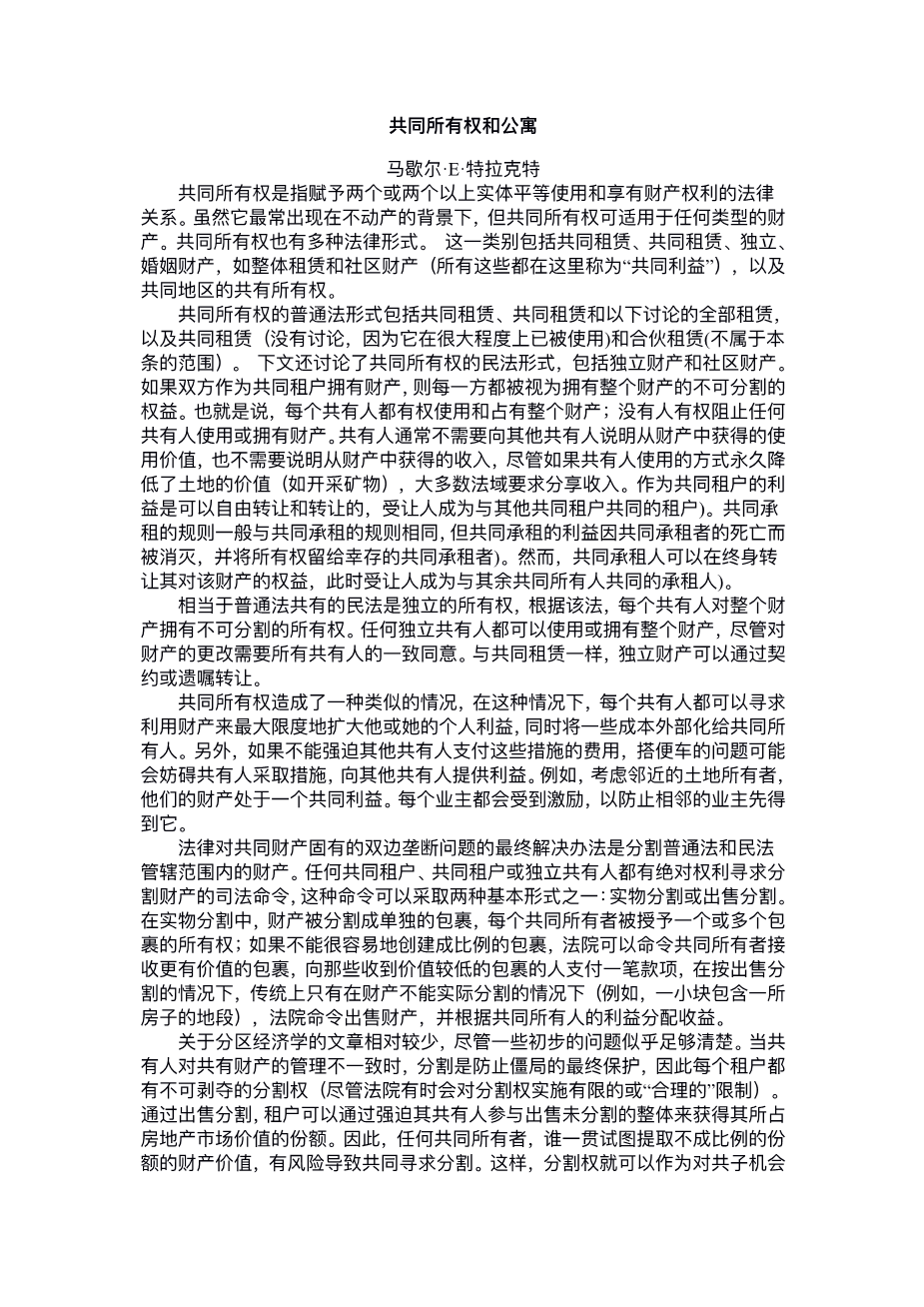共同所有权和公寓外文翻译资料
2022-08-03 11:24:29
1400
CO-OWNERSHIP AND CONDOMINIUM
Marshall E. Tracht
Associate Professor, Hofstra University School of Law
copy; Copyright 1999 Marshall E. Tracht
Abstract
Co-ownership refers to legal relations in which two or more entities have equal rights to the use and enjoyment of property. Co-ownership relationships may satisfy the preferences of some owners, and predefined categories of co-ownership, as opposed to contractually defined relations, may allow parties to satisfy these preferences at relatively low cost. However, shared ownership results in coordination and externality problems, which the law attempts to mitigate in numerous ways, including judicial oversight of lsquo;reasonablenessrsquo; (as in the law of waste) or fiduciary duties; ending the co-ownership relation (through the right of partition) or providing rules that seek to optimize the joint decision-making process (such as compulsory unitization). A major area of growth in shared ownership is in condominium developments, where entities own some property individually, while co-owning common facilities. This permits parties to take advantage of economies of scale and the joint provision of common goods. Condominium arrangements are governed by a combination of contract, statute and judicial law, and typically include democratic decision-making structures intended to minimize the sum of decision-making costs (gathering information, voting, and bargaining) and the cost of erroneous decisions.
JEL classification: K11, P32, H41
Keywords: Cotenancy, Co-ownership, Condiminium, Cooperative, Communal Ownership
- Introduction
Co-ownership refers to legal relationships that entitle two or more entities to equal rights to the use and enjoyment of property. Although it most often arises in the context of real property, co-ownership may apply to any type of property. Co-ownership also takes numerous legal forms. The category includes tenancy in common, joint tenancy, indivision, marital estates such as tenancy by the entirety and community property (all of which are referred to here as lsquo;cotenancy interestsrsquo;), as well as condominium ownership of common areas. Other important examples of co-ownership include the relationship of
62
neighboring landowners with interests in underground oil or gas reserves and communal arrangements such as kibbutzim, Hutterite or other planned communities.
In each case, the central economic and legal problem is how conflicting preferences and actions of the co-owners can be coordinated. In the absence of such coordination, owners may overindulge in activities that impose costs on their co-owners and underinvest in projects or activities whose benefits are shared with co-owners. The legal mechanisms used to cope with these externality problems range from doctrines that impose liability on co-owners for engaging in inefficient activities (such as the law of waste), to legally mandated common decision-making (as in compulsory unitization statutes), to forced termination of the co-ownership relationship (partition). In addition, successful coordination and decision-making in co-ownership situations often depend on social sanctions and norms outside the domain of law. This article explores the law and economics literature in three major related areas: common law and civil law co-ownership; condominium ownership; and communal ownership.
A. Cotenancy Relationships
- Overview of Cotenancy Relationships
The common law forms of co-ownership include tenancy in common, joint tenancy and tenancy by the entirety, each discussed below, as well as coparcency (not discussed because it has largely fallen from use) and tenancy in partnership (outside the scope of this article). Civil law forms of co-ownership, also discussed below, include indivision and community property.
If parties own property as tenants in common, each is considered to own an undivided interest in the whole property. That is, each cotenant has the right to use and possession of the entire property; and none has the right to prevent any cotenant from making use of or possessing the property. A cotenant generally need not account to other cotenants for the use value derived from the property, nor for income received from the property, although where a cotenant makes use in a way that permanently reduces the value of the land (such as extracting minerals), most jurisdictions require that the income be shared. An interest as tenant in common is freely alienable and devisable, with the transferee becoming a tenant in common with the other cotenant(s).
The rules governing joint tenancy are generally the same as those for tenancy in common, with the exception that a joint tenancy interest is extinguished by the death of a joint tenant, leaving ownership in the surviving joint tenant(s). However, a joint tenant may transfer his interest in the property during life, at which point the transferee becomes a tenant in common with the remaining co-owner(s).
Joint tenancy originated in the economic and social conditions of feudal England, in which the division of landed estates among numerous heirs would have impaired the ability to render feudal services to the lord. As feudalism passed, so too did this imperative for joint tenancy. Responding to the coordination problems inherent in concurrent ownership, England abolished legal concurrent interests in 1925. In England, a grant or devise that would formerly have created a legal concurrent estate is now deemed to create a beneficial concurrent estate, with the legal title to property held in trust for sale. Upon sale, the proceeds are allocated to the co-owners. Thus, the inefficiencies of concurrent legal ownership are avoided.
Tenancy by the entirety, recognized in approximately 20 US jurisdictions, can exist only between married
剩余内容已隐藏,支付完成后下载完整资料


英语译文共 3 页,剩余内容已隐藏,支付完成后下载完整资料
资料编号:[266253],资料为PDF文档或Word文档,PDF文档可免费转换为Word




